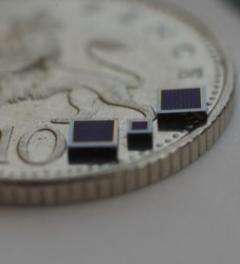The new millimetre-sized solar cells capture more of the sun's energy than traditional solar panels.
(PhysOrg.com) -- A new generation of 'nano-structured' millimetre-sized solar cells that could convert the sun's energy to electricity more than twice as efficiently as current technology, is the subject of an Imperial College London exhibit called 'A Quantum of Sol' at the Royal Society Summer Science Exhibition 2009, which opens to the public today.
Visitors to the exhibit will be able to play at being solar power engineers, and use prisms to see how much electrical power can be generated by the different colours within the spectrum of light.
The exhibit is led by Dr Ned Ekins-Daukes, a researcher from the Department of Physics and the Grantham Institute for Climate Change at Imperial, who also launches the first in a series of Grantham Institute briefing papers at the exhibition today (30 June).
The 'Quantum of Sol' exhibit explains the technology behind so-called 'third generation' solar cells. These are designed on the nano-scale, which means the materials they are made of are custom-built on a scale 1000 times smaller than the size of a human hair. These third generation solar cells can capture more of the sun's energy than existing silicon solar panels because they contain different layers of material that absorb a broader spectrum of colours. Individually targeting different colours of sunlight in this way captures more of the sun's energy, creating much more efficient solar cells.
Visitors to the exhibit will be able to see this principle in action by sliding a working solar cell through light that has been split by a prism into its constituent colours, to see how each colour generates different amounts of energy.
They will also get the chance to play the role of solar power engineers, positioning small mirrors and lenses on a board to focus a beam of light onto a miniature solar cell. This is a scaled-down representation of a type of solar technology used in the desert, known as a 'concentrator power system', where swathes of mirrors or lenses are used to focus sunlight onto small but highly efficient solar cells.
Silicon solar panels, which have been around since the 1950s and are relatively cheap to produce, lose a lot of the sun's energy, and tend to operate with just 12 - 20% efficiency. The new generation of so-called 'multi- junction' solar cells has the potential to perform much better, with the current world record for efficiency standing at 41%, and Dr Ekins-Daukes predicting that 50% efficiency will be achieved within a decade.
"One of the biggest challenges for scientists working in the solar power field is finding ways of harnessing the sun's energy more efficiently," says Dr Ekins-Daukes. "Our exhibit gives people the chance to get a hands-on understanding of the research underway at Imperial and elsewhere in the world to develop new solar cells that capture the light missed by other solar panel designs."
Although using nanotechnology to build these new solar cells is expensive at present - $14 per square centimetre - a solar concentrator system collects and focuses sunlight using inexpensive mirrors. In this way, the electricity generated can become affordable. In 2007, Imperial College London spun out a company, Quantasol, which has recently developed a particularly efficient single-junction solar cell, which forms part of the exhibit.
The international efforts to improve the efficiency of this new generation of cells and the potential for the technology to become more affordable in the future are outlined Dr Ekins-Daukes' Grantham Institute for Climate Change briefing paper - copies of which will be available at the Royal Society exhibition.
Entitled 'Solar energy for heat and electricity: the potential for mitigating climate change', the briefing paper appraises the current state of play in the solar energy field, describing solar energy's potential contribution to climate mitigation goals, and outlining what needs to be done to reach these goals.
It is the first in a planned series of briefing papers that will be published by the Grantham Institute for Climate Change to provide a source of information about key issues linked with climate change science, adaptation and mitigation. Aimed at key policy- and decision-makers, the series of briefing papers is part of the Grantham Institute's mission to generate and communicate the highest quality research on climate change and to translate this research into sustainable technological, political and socio-economic responses.
Director of the Grantham Institute for Climate Change at Imperial, Professor Sir Brian Hoskins, commented: "I'm delighted that the first of our planned briefing papers is being launched at the Royal Society's Summer Science Exhibition. This event provides a great opportunity for Dr Ekins-Daukes to share his expertise in photovoltaics with young people and the general public, whilst the briefing paper's more in-depth analysis of the broader solar energy field makes it a must-read for those in business and government charged with making decisions that will affect how we get energy and heat for our homes and workplaces in the future."
Provided by Imperial College London (news : web)



















